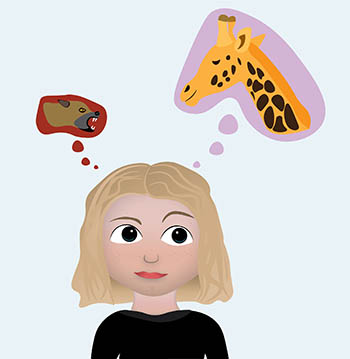The Training Page
FROM THE FELLOWS COMMITTEE
Becoming a Resilient Scientist During My Trip to the Zoo

CREDIT: ERICA WYNNE-JONES, NIAID
I first heard about resilience when I was in primary school in rural Australia. It was part of a cognitive-behavioral program at the school called “You can do it!” I volunteered to be on our “You can do it!” committee, where we would organize events based on one of the five keys to success: confidence, persistence, organization, getting along, and resilience.
Organizing events for the other keys was relatively easy, but resilience was much more difficult. As an 8-year-old, I had only the rudimentary understanding that resilience was the ability to “bounce back,” which sounded easy enough to me because I played a lot of four square handball (a game in which four players—on a square court divided into quadrants—bounce a small rubber ball back and forth between quadrants; players are eliminated when they fail to touch the ball into another player’s quadrant.)
We ended up organizing a coloring competition to build resilience in our peers. I’m not sure what we thought it had to do with resilience, but the ability to use crayons for coloring a black-and-white template seemed like an extremely valuable skill at the time. Twenty years on, I rarely use my coloring talents, and I’m learning a lot more about resilience through the monthly Office of Intramural Training and Education’s (OITE’s) series on “Becoming a Resilient Scientist.”
One of the recurring themes in the “Becoming a Resilient Scientist” series is empathetic, nonviolent communication. American psychologist Marshall Rosenberg, who developed nonviolent communication as a way to resolve conflict, coined the terms “jackal language” and “giraffe language” to describe the ways in which we can communicate. Jackal language is violent and focuses on blame. Conversely, giraffe language is empathetic and forgiving, named after the giraffe’s large heart and its tall stature, which gives it the ability to see the forest for the trees. These styles apply not only to communication with others but also within ourselves.
For me, this resilience training came sharply into focus late last year. I was going through a tough time at work and struggling in the aftermath of a difficult conversation with a colleague. So, I went to the zoo. For me, the zoo is the perfect place to decompress. You get to walk around outside, and, really, how can you be upset when you’re watching a sea lion fetch a Frisbee disk? I was halfway around the zoo when my phone died during a podcast I was listening to. I had a battery charger, but alas I had just witnessed my phone’s last digital breath. My worst nightmare. In the zoo, I was able to distract myself with cute animals, but when I boarded the Metro to go home, I was left with nothing but my own thoughts. They were raging and twisting in my head as I replayed my bad conversation over and over and thought about what had happened. “Is it all my fault? Am I a horrible person? Is the other person a horrible person?”
At that point, I was really grateful for the work and training I’d done with OITE to build my resilience. I took a step back and thought about how all sides in this situation were understandable and that communication and relationships have become more difficult for everyone during the COVID-19 pandemic. Even though those thoughts didn’t solve all of my problems, where there was once a pack of vicious jackals who would tell me horrible things about myself and others, there is now a tower of giraffes who stand tall and can help me see the whole situation with more empathy. Practicing resilience seems to be a lifelong journey, but in the moment, I was glad to be riding the Metro with giraffes and not jackals.
To register for or watch recordings of OITE’s “Becoming a Resilient Scientist” series, go to https://www.training.nih.gov/nih_becoming_a_resilient_scientist_series.
To learn about OITE’s weekly resilience discussions that focus on specific topics, go to https://www.training.nih.gov/events/upcoming.

Erica Wynne-Jones is an Australian visiting postdoctoral fellow in the Lab of Clinical Immunology and Microbiology at the National Institute of Allergy and Infectious Diseases, where she works on CD8+ T cells in viral skin infections. She is the Outreach Liaison on the Fellows Committee and is writing for and coordinating fellows’ contributions to the NIH Catalyst Training Page. Outside of work she enjoys cycling around Bethesda, cartooning, writing science-themed satirical articles and sitcoms, and performing stand-up comedy.
This page was last updated on Tuesday, February 15, 2022
